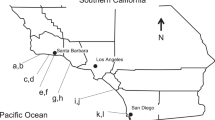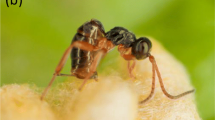Abstract
We examined whether several facultatively gregarious encyrtid (Hymenoptera: Encyrtidae) endoparasitoids of brown soft scale, Coccus hesperidum L., manifest precise sex allocation under field conditions. Metaphycus luteolus (Timberlake), Metaphycus angustifrons (Compere), Metaphycus stanleyi (Compere), and Microterys nietneri (Motshulsky) evince brood sex ratios that are female-biased and extremely precise (low variance in the number of sons per host). Typically, this sex allocation pattern is attributed to extreme local mate competition (LMC) in which only one foundress exploits a patch of hosts and mating occurs mostly between her offspring. However, such a pattern of sex allocation was not detected for Metaphycus helvolus (Compere). Also, a large proportion of the broods in all five species contained only daughters; thus, an excess of male-only broods was expected if unmated females (i.e., females that can produce only sons) contribute offspring before mating. All-male broods were rare in our samples. This finding coupled with the life history characteristics of these wasps, such as the exploitation of aggregated hosts and the long life span and mobility of males, suggest that nonlocal mating is frequent. Our empirical work suggests that it is advantageous to allocate precise sex ratios in cases in which mating opportunities for males are not restricted to their natal host and/or when multiple foundresses exploit large patches of hosts. Limited theoretical work also supports this prediction but more detailed studies of this taxon’s mating structure and other life history characteristics are necessary to understand their sex allocation decisions.


Similar content being viewed by others
References
Bartlett BR (1960) Biological races of the black scale Saissetia oleae, and their specific parasites. Ann Entomol Soc Am 53:383–385
Bartlett BR (1978) Coccidae. In: Clausen CP (ed) Introduced parasites and predators of arthropod pests and weeds: a world review. Agriculture handbook no. 480. USDA, Washington, DC, pp 57–74
Bartlett BR, Lagace CF (1961) A new biological race of Microterys flavus introduced into California for the control of lecaniine coccids, with an analysis of its behavior in host selection. Ann Entomol Soc Am 54:222–227
Bartlett BR, Ball JC (1964) The developmental biologies of two encyrtid parasites of Coccus hesperidium and their intrinsic competition. Ann Entomol Soc Am 57:496–503
Bartlett BR, Ball JC (1966) The evolution of host suitability in a polyphagous parasite with special reference to the role of parasite egg encapsulation. Ann Entomol Soc Am 59:42–45
Bernal JS, Luck RF, Morse JG (1998) Sex ratios in field populations of two parasitoids (Hymenoptera: Chalcidoidea) of Coccus hesperidum L. (Homoptera: Coccidae). Oecologia 116:510–518 doi:10.1007/s004420050616
Bernal JS, Luck RF, Morse JG (1999) Host influences on sex ratio, longevity, and egg load in two Metaphycus species parasitic on soft scales: implications for insectary rearing. Entomol Exp Appl 92:191–204 doi:10.1046/j.1570-7458.1999.00538.x
Blumberg D (1976) Encapsulation of parasitoid eggs in soft scale scales (Homoptera: Coccidae). Ecol Entomol 2:185–192
Blumberg D (1997) Encapsulation of parasitoids. In: Ben-Dov Y, Hodgson CJ (eds) Soft scale insects—their biology, natural enemies and control (7A). Elsevier, Amsterdam, pp 375–387
Charnov EL, Los-Denhartogh RL, Jones WT, Van den Assem J (1981) Sex ratio evolution in a variable environment. Nature 289:27–33 doi:10.1038/289027a0
Crawley M (1993) GLIM for ecologists. Blackwell Scientific, Oxford
Fauvergue X, Fleury F, Lemaitre C, Allemand R (1999) Parasitoid mating structures when hosts are patchily distributed: field and laboratory experiments with Leptopilina boulardi and L. heterotoma. Oikos 86:344–356 doi:10.2307/3546451
Fisher RA (1930) The genetical theory of natural selection. Clarendon, Oxford
Flanders SE (1939) Environmental control of sex in hymenopterous insects. Ann Entomol Soc Am 32:11–26
Godfray HCJ (1994) Parasitoids: behavioral and evolutionary ecology. Princeton University Press, Princeton, NJ
Godfray HCJ, Cook JM (1997) Mating systems of parasitoid wasps. In: Choe JC, Crespi BJ (eds) The evolution of mating systems. Cambridge University Press, Cambridge, pp 211–225
Green RF, Gordh G, Hawkins BA (1982) Precise sex ratios in highly inbred parasitic wasps. Am Nat 120:653–665 doi:10.1086/284018
Guerrieri E, Noyes JS (2000) Revision of the European species of genus Metaphycus Mercet (Hymenoptera, Chalcidoidea: Encyrtidae), parasitoids of scale insects (Homoptera: Coccoidea). Syst Entomol 25:147–222 doi:10.1046/j.1365-3113.2000.00099.x
Gullan PJ (1997) Relationships with ants. In: Ben-Dov Y, Hodgson CJ (eds) Soft scale insects—their biology, natural enemies and control (7A). Elsevier, Amsterdam, pp 351–373
Hamilton WD (1967) Extraordinary sex ratios. Science 156:477–488 doi:10.1126/science.156.3774.477
Hamilton WD (1979) Wingless and fighting males in fig wasps and other insects. In: Blum MS, Blum NA (eds) Reproductive competition and sexual selection in insects. Academic, New York, pp 167–220
Hardy ICW (1992) Non-binomial sex allocation and brood sex ratio variances in the parasitoid Hymenoptera. Oikos 65:143–158 doi:10.2307/3544897
Hardy ICW (1994) Sex ratio and mating structure in the parasitoid Hymenoptera. Oikos 69:3–20 doi:10.2307/3545278
Hardy ICW, Cook JM (1995) Brood sex ratio variance, developmental mortality and virginity in a gregarious parasitoid wasp. Oecologia 103:162–169 doi:10.1007/BF00329076
Hardy ICW, Dijkstra LJ, Gillis JEM, Luft PA (1998) Patterns of sex ratio, virginity and developmental mortality in gregarious parasitoids. Biol J Linn Soc 64:239–270
Hartl DL (1971) Some aspects of natural selection of arrhenotokus populations. Am Zool 11:309–325
Herre EA (1985) Sex ratio adjustment in fig wasps. Science 228:896–898 doi:10.1126/science.228.4701.896
Herre EA (1987) Optimality, plasticity and selective regime in fig wasp sex ratios. Nature 329:627–629 doi:10.1038/329627a0
Kapranas A (2002) Clutch size, pattern of sex allocation and encapsulation of Metaphycus sp. nr flavus (Hymenoptera: Encyrtidae) eggs, a facultative gregarious endoparasitoid of brown soft scale Coccus hesperidium L. (Homoptera: Coccidae). MS thesis, University of California, Riverside, CA
Kapranas A (2006) Parasitoids of brown soft scale, Coccus hesperidum L., in southern California and their reproductive strategies. Ph.D. dissertation, University of California, Riverside, CA
Kapranas A, Morse JG, Pacheco P, Forster LD, Luck RF (2007) Survey of brown soft scale Coccus hesperidum parasitoids in southern California citrus. Biol Control 42:288–299 doi:10.1016/j.biocontrol.2007.05.012
Kazmer DJ, Luck RF (1995) Size–fitness relationships in a field population of the egg parasitoid, Trichogramma pretiosum. Ecology 76:412–425 doi:10.2307/1941200
Kozár F, Ben-Dov Y (1997) Zoogeographical considerations and status of knowledge of the family. In: Ben-Dov Y, Hodgson CJ (eds) Soft scale insects—their biology, natural enemies and control (7A). Elsevier, Amsterdam, pp 213–228
Krackow S, Meelis E, Hardy ICW (2002) Analysis of sex ratio variances and sequences of sex allocation. In: Sex ratios: concepts and research methods. Cambridge University Press, Cambridge, pp 112–131
Lampson LJ, Morse JG (1992) A survey of black scale, Saissetia oleae (Hom.: Coccidae) parasitoids (Hym.: Chalcidoidea) in southern California. Entomophaga 37:373–390 doi:10.1007/BF02373111
Lampson LJ, Morse JG, Luck RF (1996) Host selection, sex allocation, and host feeding by Metaphycus helvolus (Hymenoptera: Encyrtidae) on Saissetia oleae (Homoptera: Coccidae) and its effect on parasitoid size, sex, and quality. Environ Entomol 25:283–294
Luck RF, Podoler H (1985) Competitive exclusion of Aphytis lingnanensis by A. melinus: potential role of host size. Ecology 66:904–913 doi:10.2307/1940553
Luck RF, Janssen JAM, Pinto JD, Oatman ER (2001) Precise sex allocation, local mate competition, and sex ratio shifts in the parasitoid wasp Trichogramma pretiosum. Behav Ecol Sociobiol 49:311–321 doi:10.1007/s002650000294
Maple JD (1947) The eggs and first instar larvae of Encyrtidae and their morphological adaptations for respiration. Univ Calif Publ Entomol 8:25–122
Marotta S (1997) General life history. In: Ben-Dov Y, Hodgson CJ (eds) Soft scale insects—their biology, natural enemies and control (7A). Elsevier, Amsterdam, pp 251–255
Nadel H, Luck RF (1985) Span of female emergence and male sperm depletion in the female-biased, quasi-gregarious parasitoid, Pachycrepoideus vindemiae (Hymenoptera: Pteromalidae). Ann Entomol Soc Am 78:410–414
Nagelkerke CJ (1993) Evolution of sex allocation strategies of pseudo-arrhenotokous predatory mites (Acari: Phytoseiidae). Ph.D. dissertation, University of Amsterdam
Nagelkerke CJ (1996) Discrete clutch sizes, local mate competition, and the evolution of precise sex allocation. Theor Popul Biol 49:314–343 doi:10.1006/tpbi.1996.0016
Nunney L, Luck RF (1988) Factors influencing the optimum sex ratio in a structured population. Theor Popul Biol 33:130 doi:10.1016/0040-5809(88)90002-0
Orzack SH (1986) Sex ratio control in a parasitic wasp, Nasonia vitripennis. II. Experimental analysis of an optimal sex ratio model. Evolution 40:341–356 doi:10.2307/2408814
Prinsloo GL (1997) Encyrtidae. In: Ben-Dov Y, Hodgson CJ (eds) Soft scale insects—their biology, natural enemies and control (7B). Elsevier, Amsterdam, pp 69–109
Rosenheim JA, Rosen D (1991) Foraging and oviposition decisions in the parasitoid Aphytis lingnanensis: distinguishing the influences of egg load and experience. J Anim Ecol 60:873–893 doi:10.2307/5419
Saakyan-Baranova AA (1966) The life cycleGof Metaphycus luteolus Timb. (Hymenoptera, Encyrtidae), parasite of Coccus hesperidum L. (Homoptera, Coccoidea), and the attempt of its introduction into the USSR. Entomol Rev 45:414–423
Seger J, Stubblefield JW (2002) Models of sex ratuo evolution. In: Hardy ICW (ed) Sex ratios: concepts and research methods. Cambridge University Press, Cambridge, pp 2–25
Shuker DM, Pen I, West SA (2006) Sex ratios under asymmetrical local mate competition in the parasitoid wasp Nasonia vitripennis. Behav Ecol 17:345–352, doi:10.1093/beheco/arj034
Shuker DM, Reece SE, Lee A, Graham A, Duncan AB, West SA (2007) Information use in space and time: sex allocation behaviour in the parasitoid wasp Nasonia vitripennis. Anim Behav 73:971–977 doi:10.1016/j.anbehav.2006.07.013
Sokal R, Rolf FJ (1995) Biometry. Freeman, NY
Sykes EM, Innocent TM, Pen I, Shuker DM, West SA (2007) Asymmetric larval competition in the parasitoid wasp Nasonia vitripennis: a role in sex allocation. Behav Ecol Sociobiol 61:1751–1758 doi:10.1007/s00265-007-0407-1
Visser ME (1994) The importance of being large-the relationship between size and fitness in females of the parasitoid Aphaereta minuta (Hymenoptera: Braconidae). J Anim Ecol 63:963–978 doi:10.2307/5273
Weppler R, Luck RF, Morse JG (2003) Studies on rearing Metaphycus helvolus (Hymenoptera: Encyrtidae) for augmentative release against black scale (Homoptera: Coccidae) on citrus in California. Biol Control 28:118–128 doi:10.1016/S1049-9644(03)00034-3
Werren JH (1983) Sex ratio evolution under local mate competiion in a parasitic wasp. Evolution 37:116–124 doi:10.2307/2408180
Werren JH (1984) A model for sex ratio selection in parasitic wasps: local mate competition and host quality effects. Neth J Zool 34:81–96
West SA, Flanagan KE, Godfray HCJ (1996) The relationship between parasitoid size and fitness in the field, a study of Achrysocaroides zwolferi (Hymenoptera: Eulophidae). J Anim Ecol 65:631–639 doi:10.2307/5742
Acknowledgments
We thank Leonard Nunney and Jocelyn Millar (UCR) for reviewing an earlier draft of this manuscript; and Ian Hardy and Kees Nalgerkerke for their advice in the use of the Meelis test. We also thank an anonymous reviewer and David Shuker (University of Edinburgh, UK) for their helpful comments in a previous draft of the manuscript. This study was supported in part by a USDA National Research Initiative grant (USDA-NRI 2005-01006) awarded to RFL and Jocelyn Millar and by a California Citrus Research Board grant (CRB 5500-159) awarded to JGM and RFL. We also thank the Center for Biological Control, University of California, Berkeley, for the Robert Van den Bosch Scholarship in Biological Control, awarded to the senior author. The experiments conducted herein comply with the current laws of the USA.
Author information
Authors and Affiliations
Corresponding author
Additional information
Communicated by K. Ross
Rights and permissions
About this article
Cite this article
Kapranas, A., Pacheco, P., Forster, L.D. et al. Precise sex ratios manifested by several encyrtid parasitoids (Hymenoptera: Encyrtidae) of brown soft scale, Coccus hesperidum L. (Hemiptera: Coccidae). Behav Ecol Sociobiol 62, 901–912 (2008). https://doi.org/10.1007/s00265-007-0514-z
Received:
Revised:
Accepted:
Published:
Issue Date:
DOI: https://doi.org/10.1007/s00265-007-0514-z




